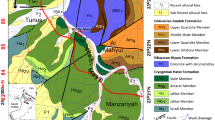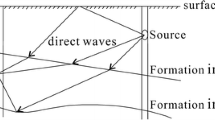Abstract
In this study, a seismic refraction survey was conducted to map the topography of bedrock in Al-Amrat, North of Sultanate of Oman. The targeted rock lies beneath unconsolidated rocks. A number of seismic profiles in the area were acquired, analyzed, and interpreted. The tomographic inversion of the data produced high resolution velocity models that contributed to understand the formations of interest. The formations are found to be characterized by variation in thickness and velocity which indicates variation in lithology and consolidation. The velocity sections were then used to build 3-D depth map that helped to understand the distribution of porous and permeable formations responsible for charging a water-producing well in the area. To support our interpretation, the data were calibrated with the exposed rocks in the survey area and showed good correlation.
Access provided by Autonomous University of Puebla. Download conference paper PDF
Similar content being viewed by others
Keywords
1 Introduction
Seismic refraction methods are based on Snell’s law, which governs the refraction of propagating waves across the boundary between layers of different physical properties. Once these waves at surface are recorded, they can be used to derive the properties of the rock along which they have traveled. The list of properties are, velocities of the rock, its depth, thickness etc.
Recent advances in seismic equipment, software packages, and interpretation techniques have led seismic refraction methods to be an effective and economical tool for numerous hydrological applications, engineering operations, in addition to mineral and petroleum exploration. The simplicity of the methods and their applicability in different environments have played key roles in their popularity. In literature, an increasing number of published papers such as: Avalos et al. [1], Zhao and Xu [2] and Osazuwa and Chinedu [3] among many others, have demonstrated the success of refraction tomography in characterizing near surface formations.
In this study, seismic data were acquired from 8 profiles crossing a dry valley in Al-Amrat, north of Sultanate of Oman. The main objective of the survey was to map the surface of the refracting bed rock and overlying unconsolidated rocks which allow ground water to charge a well in the area.
2 Methods
The survey was designed to image the depth of the bedrock surface. It consists of 8 lines with twenty four 4.5 Hz geophones. The geophones were spaced at 3 m intervals and planted for optimum physical contact with the ground. The lines were distributed on the area to ensure a good coverage of the area around the well. For calibration purposes, some lines crossed the bedrock which was exposed on surface. The well is located in the southern part of the survey area as displayed in Fig. 1. For each line, 5 shots were recorded. The data were then loaded to a software and prepared for inversion by correcting the geometry and picking first arrivals for all the shots. Tomography would allow lateral velocity variations and vertical gradients to be imaged, as opposed to most conventional refraction interpretation methods, which produce constant velocity layers.
3 Results and Discussion
First arrival times for the lines were used to build an initial model for the tomographic inversion. In this type of inversion, the final model depends heavily on the characteristics of the initial velocity model. After several tests, a velocity model was obtained for each line. The observation of inverted sections revealed that the hard basement rock and the overlying formations both vary in velocity and thickness. The variation in velocity can be associated with the degree of consolidation of these sediments, their porosity and permeability. In fact, the low velocity is an indication of low consolidation, high porosity and permeability while high velocity indicates high consolidated and less porous material. Line 1, for example, shows a very clear depression in a form of low velocity trend that appears in other lines that have been shot in the same direction (Figs. 2 and 3). This indicated the presence of low consolidated like-channel structure that possibly allows the water to pass to the well.
At later stage, the 2-D velocity models derived from tomographic inversion were used to produce a 3-D map of the targeted bed. The resulting map is displayed in Fig. 4. The map provided another reliable interpretation of the target. As the bedrock was exposed on surface, this has allowed us to calibrate the obtained images with the real geology.
Note that several tests were conducted to evaluate the accuracy of the above tomographic models. This includes solution robustness and stability in addition to the direct comparison with geology and exposed formations.
4 Conclusion
Seismic refraction tomography was applied to map the topography of consolidated rock and overlying zones in Al-Amrat, Sultanate of Oman. The consolidated rock was characterized by high velocity and thickness variation. The overlying layers showed low velocity trend that was observed in different lines and interpreted to be porous channel that might be responsible for the water passage to charge water-well in the area. The 3-D map obtained from the velocity sections calibrated with the exposed formations on surface have provided more support to our interpretation.
References
Avalos, E., Malone, D., Peterson, E., Anderson, W., Gehreles, W.: Two dimensional seismic refraction tomography of a buried bedrock valley at Hallsands beach, Devon, United Kingdom. Environ. Geosci. 23, 179–193 (2016)
Zhao, Z., Xu, J.: Geological structure investigation of shallow layers by the explosion seismic survey tomographic technique. J. Environ. Eng. Geophys. 15(1), 21–28 (2010)
Osazuwa, I.B., Chinedu, A.D.: Seismic refraction tomography imaging of high permeability zones beneath an earthen dam, in Zaria area, Nigeria. J. Appl. Geophys. 66, 44–58 (2008)
Author information
Authors and Affiliations
Corresponding author
Editor information
Editors and Affiliations
Rights and permissions
Copyright information
© 2019 Springer Nature Switzerland AG
About this paper
Cite this paper
Farfour, M., Al-Hosni, T. (2019). Application of Seismic Refraction Tomography to Map Bedrock: A Case Study from Al-Amrat, Oman. In: Sundararajan, N., Eshagh, M., Saibi, H., Meghraoui, M., Al-Garni, M., Giroux, B. (eds) On Significant Applications of Geophysical Methods. CAJG 2018. Advances in Science, Technology & Innovation. Springer, Cham. https://doi.org/10.1007/978-3-030-01656-2_23
Download citation
DOI: https://doi.org/10.1007/978-3-030-01656-2_23
Published:
Publisher Name: Springer, Cham
Print ISBN: 978-3-030-01655-5
Online ISBN: 978-3-030-01656-2
eBook Packages: Earth and Environmental ScienceEarth and Environmental Science (R0)








